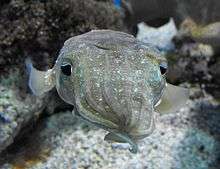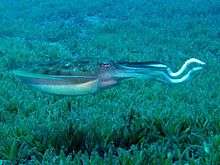Pharaoh cuttlefish
| Pharaoh cuttlefish | |
|---|---|
 | |
| Scientific classification | |
| Kingdom: | Animalia |
| Phylum: | Mollusca |
| Class: | Cephalopoda |
| Order: | Sepiida |
| Family: | Sepiidae |
| Genus: | Sepia |
| Subgenus: | Sepia |
| Species: | S. pharaonis |
| Binomial name | |
| Sepia pharaonis Ehrenberg, 1831 | |
| Synonyms | |
| |
The pharaoh cuttlefish (Sepia pharaonis) is a large cuttlefish species, growing to 42 cm in mantle length and 5 kg in weight.[1] When raised in the laboratory, the maximum recorded size for males is 16.2 cm, and for females 15.5 cm.[2]
Sepia pharaonis is likely a complex of at least three species, Sepia pharaonis I, commonly located in the Red Sea and Persian Gulf, S. pharaonis II, located from Japan to the Gulf of Thailand and northern Australia; and S. pharaonis III, located from the Indian Ocean to the Andaman Sea.[3]
The type specimen was collected in the Gulf of Suez and is deposited at the Zoologisches Museum in Berlin.[4]

Range and habitat
The pharaoh cuttlefish is native to at least the western Indian Ocean, including the Red Sea and Persian Gulf.[5] Of all the cuttlefish species in the Persian Gulf, it is the most commonly caught. Inhabiting the neritic zone, it is often found in depths up to 130 m.[2] When hunting at night, it swims up to shallower parts of the sea to feast on a variety of smaller fish, crabs, and occasionally other cuttlefish.[6]
They have been observed to exhibit migratory behavior off of the south-west coast of India.[7] They are more commonly found furthest north during August, and further south in May.[7] They show an even distribution in October and February. Additionally, there are more juveniles present in May, and more adults present in August.[7]
The Pharaoh cuttlefish prefer a medium to high amount of sunlight for den location during the day. Additionally, they prefer mud substrata during the day, but during the night prefer sand or mud substrata equally.[8]
Reproduction
Spawning times vary depending on its habitat. Near Hong Kong, it mates during Spring, from March to May. In the Red Sea area, it takes place from August to October.[6] After mating, the female deposits her eggs near the coast, between depths of 5 and 20 m.[2]
Pharaoh cuttlefish reproduce the same way as most other cuttlefish. Large males compete in combat until a victor is decided. This combat is often decided without any physical contact. The males circle each other performing threatening displays of color and tentacles until one male swims off in defeat. The victorious male then mates with females by grabbing them with their tentacles, turning the female so that the two animals are face-to-face, then using a specialized tentacle to insert sperm sacs into an opening near the female's mouth. The male then guards the female until she lays the fertilized eggs a few hours later.[9]
Coloring
Pharaoh cuttlefish often show a solid color when resting on a solid color background, alternating from a pale white to all dark brown. Additionally, they can show a mottled white and brown color, with a center circle of brown. The mechanism for color is the same in the Pharaoh cuttlefish as it is in other cuttlefish. This colour-changing function is produced by groups of red, yellow, brown, and black[10] pigmented chromatophores above a layer of reflective blue and green tinted iridophores and leucophores, with up to 200 of these specialized pigment cells per square millimeter.[11] These sacs of color are controlled by rings of muscle around the sac. The cuttlefish expands and contracts these muscle rings in order to show different colors.
Human uses
It is a commonly fished species of cuttlefish in the Philippines, as well as the most economically important cuttlefish in the northern Indian Ocean. Off the coast of Australia, 90% of the cuttlefish caught are S. pharaonis.[2] It is often eaten by humans in these areas. Typically, cuttlefish is consumed as dried, shredded cuttlefish, a popular snack food. And, in the Qing Dynasty manual of Chinese gastronomy, the Suiyuan shidan, the roe of the cuttlefish is considered a difficult to prepare but sought-after delicacy.[12]
Additionally in the past Cuttlefish ink was an important dye, called sepia. Today, artificial dyes have mostly replaced natural sepia.
See also
References
- ↑ Reid, A., P. Jereb, & C.F.E. Roper 2005. Family Sepiidae. In: P. Jereb & C.F.E. Roper, eds. Cephalopods of the world. An annotated and illustrated catalogue of species known to date. Volume 1. Chambered nautiluses and sepioids (Nautilidae, Sepiidae, Sepiolidae, Sepiadariidae, Idiosepiidae and Spirulidae). FAO Species Catalogue for Fishery Purposes. No. 4, Vol. 1. Rome, FAO. pp. 57–152.
- 1 2 3 4 Tehranifar, Akram (2011). "General morphological characteristics of the Sepia Pharaonis (cephalopoda) from Persian Gulf, Bushehr region" (PDF). 11. IACSIT Press. Retrieved 4 October 2011.
- ↑ "Sepia pharaonis (Pharaoh Cuttlefish)". www.iucnredlist.org. Retrieved 2016-04-10.
- ↑ Current Classification of Recent Cephalopoda.
- ↑ Norman, M.D. (2000). Cephalopods: A World Guide. ConchBooks.
- 1 2 Nair (June 1993). "Stock assessment of the pharaoh cuttlefish Sepia pharaonis" (PDF). Indian Journal of Fisheries. Central Marine Fisheries Research Institute. 40: 85–94. Retrieved 9 October 2011.
- 1 2 3 Chembian, A. John; Mathew, Saleena (2011). "Migration and spawning behavior of the pharaoh cuttlefish Sepia pharaonis Ehrenberg, 1831 along the south-west coast of India". Indian Journal of Fisheries. 58 (3): 1–8. Retrieved 2016-03-24.
- ↑ Nabhitabhata, Jaruwat; Nilaphat, Pitiporn (2000). "Behaviour of Juvenile Cephalopods: Preference for Texture and Brightness of Substrata". Phuket Marine Biological Center Special Publication. 21 (1): 103–112. Retrieved 2016-03-24.
- ↑ "Cuttlefish Husbandry: Part IV - How do cuttlefish reproduce? - The Cephalopod Page". www.thecephalopodpage.org. Retrieved 2016-04-10.
- ↑ Messenger, J. B. (2001-11-01). "Cephalopod chromatophores: neurobiology and natural history". Biological Reviews. 76 (4): 473–528. doi:10.1017/S1464793101005772. ISSN 1469-185X.
- ↑ "NOVA | Kings of Camouflage | Anatomy of a Cuttlefish (non-Flash) | PBS". www.pbs.org. Retrieved 2016-03-29.
- ↑ "Page not found – Translating the Suiyuan Shidan". Retrieved 2016-03-29.
External links
- "CephBase: Pharaoh cuttlefish". Archived from the original on 2005.